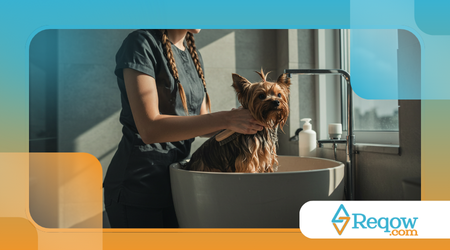Bathing and Grooming: Ideal Frequency for Each Type of Pet

Maintaining your pet's hygiene is essential for its health and well-being, and ideal frequency of bathing and grooming varies according to the breed, coat type and lifestyle of the animal.
Advertisements
While some dogs and cats need regular baths, others should be bathed less frequently to avoid skin problems.
In addition to bathing, the proper shearing contributes to the pet's comfort and hygiene, helping to control hair loss and prevent infections.
But how do you know the right routine for each type of animal? In this article, you'll find out how often should your pet be bathed and groomed, as well as essential tips to ensure efficient and safe hygiene.
The Importance of Bathing and Grooming for Pets' Health
Animal hygiene care goes beyond aesthetics. proper bath removes dirt, bacteria and residues accumulated on the skin and hair, preventing irritations, allergies and unpleasant odors.
Advertisements
THE shearing also plays a fundamental role, especially in long-haired breeds, preventing entanglements, accumulation of dirt and proliferation of parasites.
Main benefits of bath and grooming:
- Prevention of skin diseases and infections.
- Control of parasites such as fleas and ticks.
- Bigger thermal comfort in hot climates.
- Reduction of hair loss around the house.
Each pet has specific needs, and following the correct frequency for your hygiene is essential to avoid skin problems and ensure your health.
Ideal Bath Frequency for Dogs
The need for bathing dogs varies according to the size, coat type and activity level of the animal.
1. Short-haired dogs
Recommended frequency: Every 30 to 45 days.
- Breeds like Dalmatian, Boxer and Doberman they produce less oil on the skin and do not need frequent bathing.
- Excessive bathing can dry out your skin and cause flaking.
- To maintain hygiene, use wet wipes between baths.
Read also about: Tips for Keeping Your Pet Parasite-Free
2. Medium-haired dogs
Recommended frequency: Every 15 to 30 days.
- Breeds like Golden Retriever, Border Collie and German Spitz accumulate more dirt and require moderate care.
- Using moisturizing shampoos helps maintain a healthy coat.
- Weekly brushing helps remove dead hair and prevents knots.
3. Long-haired dogs
Recommended frequency: Every 15 days.
- Breeds like Shih Tzu, Lhasa Apso and Maltese accumulate dirt more quickly.
- Long hair gets tangled easily and requires frequent brushing.
- If necessary, opt for dry bath between intervals to maintain cleanliness.
4. Dogs with Curly or Dense Hair
Recommended frequency: Every 15 to 30 days.
- Breeds like Poodle and Bichon Frise They have curly hair that requires frequent hydration.
- Moisture retained in the coat can promote fungal infections, so it is essential dry the dog well after bathing.
5. Double-Coated Dogs
Recommended frequency: Every 30 to 45 days.
- Breeds like Siberian Husky, Akita and Samoyed They have a coat that protects against climate changes and should not be washed too often.
- Excessive bathing can remove the skin's protective layer, causing dermatological problems.
6. Dogs Prone to Skin Problems
Recommended frequency: According to veterinary guidance.
- Dogs with dermatitis or allergies should follow a specific routine, with medicated shampoos recommended by the veterinarian.
Ideal Bath Frequency for Cats
Cats are known for their natural self-cleaning, but in some cases, bathing may be necessary.
1. Shorthair Cats
Recommended frequency: Every 2 to 3 months, or only when really necessary.
- Breeds like Siamese, American Shorthair and Sphynx They clean themselves and rarely need a bath.
- In cases of excessive dirt or contact with sticky substances, bathing can be done with specific shampoo for cats.
2. Long-haired Cats
Recommended frequency: Every 30 to 45 days.
- Breeds like Persian and Maine Coon require more care to avoid knots and dirt build-up in the coat.
- Daily brushing reduces the need for frequent baths.
3. Cats with Skin Problems
Recommended frequency: As per veterinary advice.
- Medicinal baths may be recommended to treat allergies, dermatitis, and fungal infections.
Tip: To reduce your cat's stress during bathing, use warm water, gentle movements and dry the animal well after the procedure.
The Importance of Grooming and Its Ideal Frequency
THE shearing It is essential to maintain the hygiene and thermal comfort of pets, especially those with long or curly hair.
Ideal Grooming Frequency for Dogs:
- Long-haired breeds: Every 30 to 45 days.
- Medium-haired breeds: Every 60 days.
- Short-haired breeds: Only for hygiene, such as hygienic grooming.
Ideal Frequency of Cat Grooming:
- Short-haired cats generally do not need clipping, just regular brushing.
- Long-haired cats may need grooming every 2 to 3 months to avoid knots and dirt build-up.
THE hygienic grooming It is recommended for dogs and cats to keep their intimate areas clean and prevent dirt build-up.
Keeping Your Pet Hygiene is Essential
Set the correct frequency of bath and grooming ensures that your pet has a healthy skin, well-groomed hair and a better quality of life.
Before establishing a fixed routine, consider:
- Coat type and breed needs.
- Pet lifestyle (whether he goes out a lot or just stays at home).
- Veterinarian's guidelines, especially for pets with sensitive skin.
Maintaining a proper hygiene schedule prevents health problems and provides more comfort and well-being for your pet.
FAQ: Frequently Asked Questions about Bathing and Grooming
1. Can I bathe my pet at home?
Yes, but it is important to use it specific shampoos for animals and ensure that the pet is very dry after bathing.
2. What is the best way to dry a pet after bathing?
The ideal is to use absorbent towels and dryers with warm temperature, avoiding excessive humidity.
3. Can grooming be harmful to your pet?
It depends on the breed. Some double-coated breeds shouldn't be shaved completely, as their coat protects against weather changes.
4. Can puppies take a bath?
Yes, but only after the first dose of vaccines, usually from the two months old.
5. What signs indicate that my pet needs a bath?
Strong odor, excessive dirt in the coat, and frequent itching are signs that it's time for a bath.
